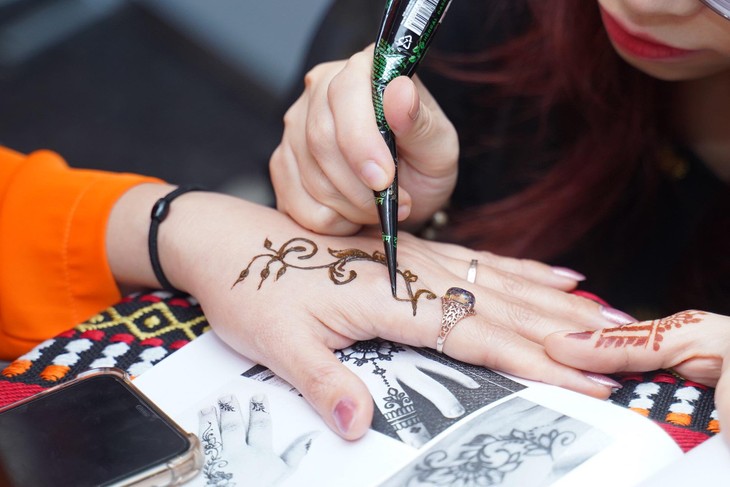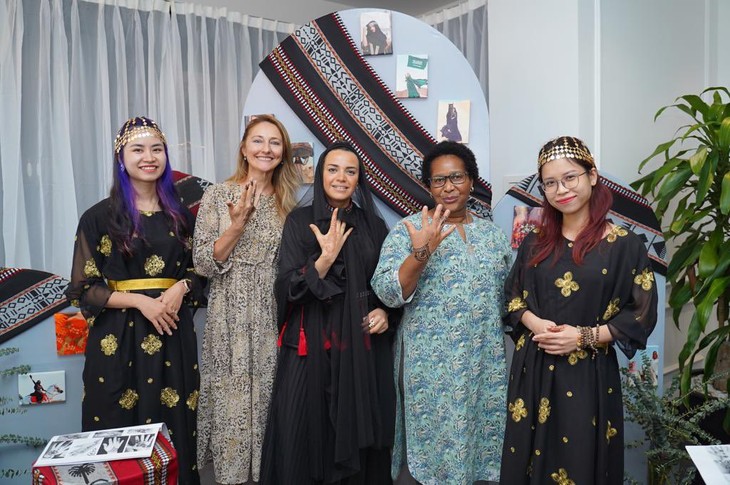(VOVWORLD) - Traditionally, henna is used to paint blessings on the skin of most brides before a Muslim wedding ceremony. At a recent gathering in Hanoi to introduce the social and cultural transformation of Saudi Arabia, many guests showed interest in henna painting, a traditional art of Islamic culture. Dr. Hiba Mostafa S. Mahros, the wife of the Ambassador of the Kingdom of Saudi Arabia to Vietnam, will talk to us today about the art form.
 Visitors to Saudi Arabia's social and cultural transformation event in Hanoi find interested in henna painting. (Photo: Embassy of the Kingdom Saudi Arabia) Visitors to Saudi Arabia's social and cultural transformation event in Hanoi find interested in henna painting. (Photo: Embassy of the Kingdom Saudi Arabia) |
Bao Tram: Thank you, Madam Hiba Mostafa Mahros, for joining us today.
Madam Hiba Mahros: Hi, VOV listeners. I’m very glad to participate in the interview.
Bao Tram: The art of henna has spread outside the Middle East and has become known more widely in the world. Tell us about henna.
Madam Hiba Mahros: The philosophy of henna is natural cooling. It has natural cooling properties for people who live in the desert. In countries dominated by desert, they use henna to help control their body temperature. They make a paste from crushed dried leaves of the henna plant and soak their palms and the soles of their feet in it to get a cooling effect. That’s the original philosophy of henna. The cooling sensation was felt throughout the body for as long as the henna stain remained on their skin. The stain faded away and left a pattern, a special pattern of the henna on the skin. The idea of painting with henna - flower patterns, or special patterns – was to create a cooling effect on the skin for residents of the desert. That was the original philosophy of henna.
Bao Tram: So what is henna? You said it leaves a stain on the skin. Is it toxic to apply it to large areas of the body?
Madam Hiba Mahros: Actually, henna is a small tree or shrub, scientifically named Lawsonia, this is the English name of henna, which has a soft, earthy feel with white or reddish flowers. It contains a reddish orange dye that bonds with the keratine in the skin, in human skin, and the stain – it’s safe. It’s from a plant. No, actually there is toxicity in henna. Some people have an allergy to henna and they have to avoid henna paint.
Bao Tram: What does the art of henna symbolize? Is there any cultural or religious significance?
Madam Hiba Mahros: Usually, we use the henna art the night before a bride gets married. Her family, relatives, and friends get together to celebrate the wedding to come. This night, called the henna night, is filled with games and music performances and henna paint and all the family come and friends of the bride come for the henna painting. The bride gets extensive henna patterns painted on her feet and hands. The henna will reach from her hands to her elbows and from her feet to her knees. It can take hours to paint the bride with multiple patterns. There are no specific rules, though there is a reference to the obligatory use of henna art in the Quran, but it's the most common practice in Islamic culture around the world.
 Dr. Hiba Mostafa S. Mahros (C) and the guests at the gathering (Photo: Embassy of the Kingdom Saudi Arabia) Dr. Hiba Mostafa S. Mahros (C) and the guests at the gathering (Photo: Embassy of the Kingdom Saudi Arabia) |
Bao Tram: Why is the bride painted with henna patterns?
Madam Hiba Mahros: It's decorative for the bride, and this is our culture. Most countries in the Middle East, Pakistani culture, Hindi culture, and a lot of other cultures do this. The culture has become famous.
Bao Tram: Are all henna patterns the same in various communities - in Saudi Arabia, India, and Pakistan, for example?
Madam Hiba Mahros: There are multiple patterns and multiple characteristics of henna art. In Saudi Arabia, henna patterns are usually less dense than the Indian patterns or Pakistani patterns. The designs usually feature large flowers with vine patterns on the hands and feet. Usually, we paint henna on the hands, also on the feet, like a tattoo for decoration.
Bao Tram: But I see on the Internet pregnant women who have painted henna patterns on their bellies. Is that common?
Madam Hiba Mahros: No, it's not common in our country. In our country, we usually put henna on our hands and feet, and usually we put henna on especially at the end of Ramadan to celebrate the Eid al-Fitr and celebrate the closing of the holy month. I mean we can attend the Eid al-Fitr with henna.
Bao Tram: Is henna painting a profession for women only or can both men and women engage in the craft?
Madam Hiba Mahros: Because ladies are more interested in drawing and more interested in having a tattoo, it’s a feminine profession. This is our culture. By the way, henna has a lot of medical benefits. Henna, if you have ground henna, you can mix it with honey and milk and oil to make a good mask for your hair. And henna can treat a fungal infection or a fungal condition of your hair or your skin, and also it makes your scalp very clean after using a henna mask.
Bao Tram: Thank you for spending time with us today.
Madam Hiba Mahros: Thank you for inviting me to this interview to introduce our Saudi culture.